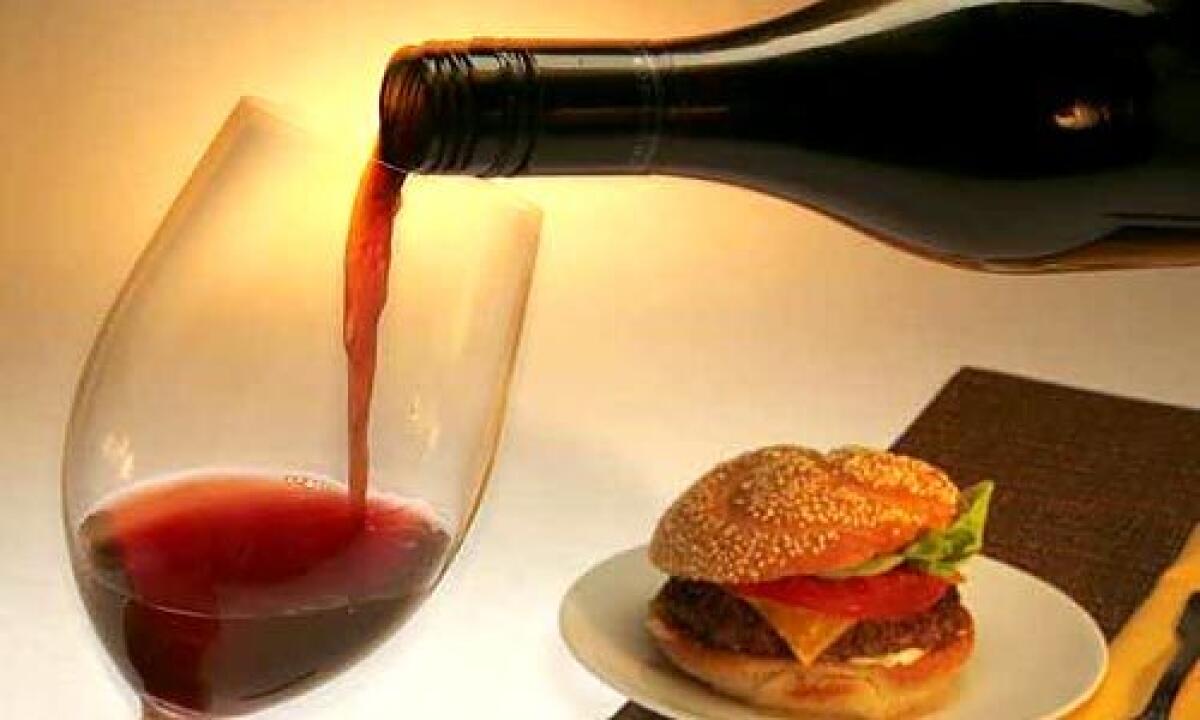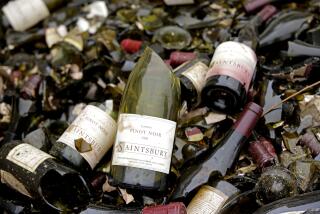Pinot Noir: Spreading the wealth

SOMETIMES it seems as if Pinot Noir isn’t so much a beverage as an exclusive private club. Scan the pages of wine magazines and you’ll find glowing reviews on a bewildering array of Pinots from unfamiliar wineries, each with tiny, hundred-case productions, lovingly extracted from tiny, single vineyards, even from tiny blocks of tiny, single vineyards.
Every so often, you might find one of these wines at a wine shop, but chances are if you’re reading about it today, it was sold out last week. You might discover a bottle on a chichi restaurant wine list, and you’ll shell out quite a few chis for the privilege of tasting it. Or you may get hold of a bottle by adding your name to the waiting list of a winery’s buying club -- which might have an opening in 2012.
It starts to feel a bit like unrequited love. What is the Pinot lover to do when the object of affection is so exclusionary, unobtainable? What if, instead of trophy worship, you wanted to make Pinot your house wine, the wine to pour each evening at dinner -- without taking out any sub-prime loans? Where are the Pinots for the rest of us?
In fact there are plenty made in volumes that resemble rivers and not trickles, and with price tags that are pretty populist. And while these may not be the most au courant bottlings in the market, they can be very, very good. Some are being made by winemakers who have taken on the challenge of affordable Pinot with the zeal of evangelists.
An exclusive grape
PINOT NOIR has always lent itself to exclusivity. It is notoriously difficult to grow (not for nothing is it called “the Heartbreak Grape”), and its trademark delicacy is easy to muck up in the winery. It requires kid-glove care from the crush pad to the bottle. None of these traits recommends the grape to mass production.
Pinot’s ancestral home is Burgundy, a small region set in a marginal growing area that often results in minuscule yields. The region’s finest bottlings, from Premier Cru and Grand Cru vineyards, amount to less than 15% of its output, but they’ve come to dominate our perception of Burgundy, serving as poster children for the intricacies of terroir -- how soil and climate express themselves in the wine. The cru vineyards themselves are modest in size, nearly always shared, subdivided down to the vine row. The result is limited, coveted bottlings that command prices commensurate with their singularity.
It’s easy to understand why American producers would want to ally themselves with this cru model, it implies pedigree and commands top dollar. But Oregon winemaker Sam Tannahill, for one, is skeptical. “Single vineyard wines can be really good,” he says, “but just because you only make 300 cases, it doesn’t mean you should charge $75 a bottle. So many come right out of the gate with prices that are not reflective of cost -- they’re reflective of ego, or what the market can bear, or of what their neighbors are charging.”
In the last few years, Tannahill has devoted a good portion of his professional life to making “Pinot for the people.” With wife Cheryl Francis and partners Bill and Deb Hatcher, he owns A to Z Wineworks in Dundee, Ore., founded in 2002 to take advantage of a glut of Oregon Pinot Noir as hundreds of new vineyard acres started bearing fruit.
But the Pinot-buying frenzy after the movie “Sideways” brought an abrupt end to the glut. The A to Z partners scrambled to lock up long-term contracts with growers statewide, ensuring a reliable pipeline of fruit just as demand skyrocketed. In the few years since, A to Z has become the state’s fastest growing winery and one of its largest producers of Pinot Noir. There are no reserves, no vineyard designates and no wines more than $20.
Before A to Z, Tannahill made wine at Archery Summit, the maker of Oregon’s most expensive wines at the time. Tannahill still makes premium wines -- he and his wife own the Francis Tannahill brand -- but says his priorities have shifted. “It gives me so much more satisfaction,” he says, “to make a great $16 wine than to make the one for $45 or $50.”
He’s not alone. Every gainfully employed Pinot craftsman was once an intern, a student, or a cellar rat pining for an affordable bottle, even if their ambitions went in other directions. “When we were students, we dreamed about making a wine so expensive we couldn’t afford to drink it,” De Loach winemaker Greg La Follette says with a laugh. La Follette has made his share of expensive Pinot Noir, with Hartford Court Winery, with the great artisanal winery Flowers on Sonoma’s outer coast, and with his own brand, Tandem.
The problem of affordable Pinot hadn’t occurred to him until 2004, when a man approached him at his own barbecue party and offered to help flip burgers. This was Jean-Charles Boisset, scion of a Burgundy family. Boisset offered La Follette the winemaking job at De Loach Winery in Santa Rosa, where he intended to offer Pinot at an affordable price -- something of an anomalous mission for a Burgundy man.
A Pinot on every table
LA FOLLETTE saw the light immediately. “I’d been chasing this ideal, these ultra-high-end trophy Pinots that I couldn’t afford to drink,” says La Follette, “and this guy comes to me and says, ‘If you really want to spread the gospel, make a Pinot that can be on everybody’s table every night.’ ”
At De Loach, La Follette makes two Pinots for less than $20; a Russian River and a California bottling.
It’s no easy feat. Pinot gets expensive because much of the winemaking required to tweak its distinctive features is risky and high-flying. “We have to do some pretty nutty things,” La Follette says, reciting a long list of interventions, including long, cold soaks; stem additions; wild, indigenous yeast fermentations; and impossibly gentle handling. “You have to roll up your sleeves. You need a smart, nimble crew.”
This is especially true when production is in the tens of thousands of cases, and instead of a small 2-ton fermenting tank, there’s one 10 times that size. At De Loach, La Follette uses commercial yeasts and has introduced mechanical innovations for things he’d otherwise do by hand.
Another factor behind Pinot’s high prices has been the rising cost of land. “For land today,” explains winemakerSusan Doyle of MacMurray Ranch, “you’re looking at $100,000 an acre. It’s no surprise that new wineries are trying to recoup their investment.”
Fortunately for Doyle, MacMurray Ranch is owned by E&J Gallo, a company that has nearly 60 years worth of vineyard assets to draw upon. Kendall-Jackson’s ever-reliable Pinot brands, Cambria in the Santa Maria Valley, and La Crema, in Sonoma County, have the same advantage.
Doyle has worked with her share of artisanal wines in Tasmania and Australia, where she’s from, as well as with La Follette at Tandem. But she appreciates value.
“I worked as a waitress to put myself through university,” she says. “At 18 years old, I got exposed to some wonderful Burgs -- but if it wasn’t for the restaurant, how would I get to drink them? It taught me early on that this should be an experience that many people should have.”
MacMurray Ranch makes several Pinots, but its broad appellation bottlings from the Central Coast and Sonoma Coast are widely available and, for the money, terrific.
So what is the trade-off when you’re buying Pinot Noir in the under-$25-per-bottle price range?
Generally speaking, large-production Pinot Noir is lighter and less complex than higher-end wines, with a sense of place or terroir that’s considerably fuzzier than the single-vineyard wines. Instead of a wine reflecting the firm, blue- tinged flavors of Cargasacchi Vineyard in the Santa Rita Hills, say, or the wind-buffeted fruit intensity that characterizes Momtazi Vineyard in McMinnville, Ore., -- you’ll come away with a broader sense of place.
Blending can also smooth out the funkier, more idiosyncratic elements. What you’re left with is kind of an essence of Pinot Noir: bright red-fruit aromatics, succulent red cherry and strawberry flavors, generous fruit, a hint of earth, a hint of herb. They may not haunt you, these wines, but they will often charm you, and they certainly have the capacity to satisfy.
“You’ve almost got to be as crazy as the grape itself to work with it,” Doyle says. “But I feel lucky to be able to play with it on such a scale.”
More to Read
Sign up for our L.A. Times Plants newsletter
At the start of each month, get a roundup of upcoming plant-related activities and events in Southern California, along with links to tips and articles you may have missed.
You may occasionally receive promotional content from the Los Angeles Times.






